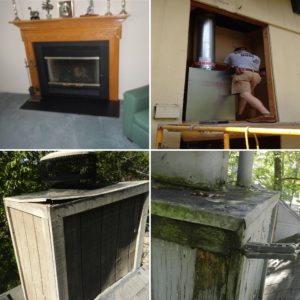What is a prefabricated fireplace?
To understand the answer, we must first understand what a fireplace is. A fireplace is a system used for the purpose of burning wood. The system consists of a firebox, smoke chamber, and flue. Other components, such as dampers and ash dumps, may be present.
Prefabricated fireplaces were designed to reduce the cost of production and the amount of time needed for installation. These systems are designed and constructed at a standard location. They are then shipped in pieces to be installed as a complete unit. It is imperative that these systems are installed following the manufacturer’s exact instructions. Instead of being manufactured out of masonry materials, these systems are usually manufactured out of steel or similar materials. The fireboxes are metal, as are the flues attached to them. Generally, these systems are listed with UnderwritersLaboratories (UL).
Why Use Prefabricated Fireplaces
Prefabricated systems are frequently installed as a cost saving measure. In most cases, the typical system costs a few thousand dollars including the installation. Prefabricated systems are tested under strict guidelines in order to qualify for UL listing. New systems are rated for multiple fuel types including wood and gas. Slots are commonly pre-cut to allow for easy conversion to these various fuel types.
Why Not Use Prefabricated Fireplaces
There is an old adage, “you get what you pay for”. When looking at masonry chimney systems, they cost significantly more than pre-fabricated systems. But they also last much longer. Usually, a masonry system will last for at least as long as the house. In some cases, the chimney may outlast the home resulting in a “stand-alone” chimney. Conversely, chimney industry experts regard prefabricated systems as disposable, with a usable life of 10 to 30 years depending on usage.
Prefabricated systems are disposable as a function of the materials they are constructed from. Metal is an excellent conductor of heat. It works well for radiating heat into a room. However, metals oxidize when exposed to moisture. This process causes prefabricated systems to deteriorate from the outside in. Keep in mind, the chimney is under constant assault from the elements. Over time, the chase cover may become compromised or the chase walls (usually being made of composite wood or particle board) may start absorbing water (e.g. rain). As the moisture penetrates the exterior of the chimney structure, it will leak onto the prefabricated system. The portion of the firebox that is closest to the elements, the outside wall, will begin to deteriorate after 20 to 30 years. Usually, if you expose those walls after that period of time, you are likely to find holes in the outside walls. Unfortunately, by the time rusting or pitting is seen in the firebox, the outside wall may be missing entirely.
In addition, since metal is such an excellent conductor of heat, high temperature fires will cause warping of the metal. This can be seen as the walls of the firebox become distorted in shape. As the metals heat and cool, the connection between the sections of chimney pipes can become compromised. The sections will start to come loose. In some cases, the sections will breach.
Like other items with modular components, you can replace parts within these systems. Refractory panels, for example, can be replaced. Please note, older prefabricated systems may not use the newer refractory panels. However, for the UL listing to be maintained, replacement parts must be original, OEM parts. In many cases, manufactures change or close and OEM parts are not available. Further, existing manufacturers may phase out older lines resulting in the lack of availability of parts. After 10 to 20 years, the original parts are no longer available. As a result, the whole system (firebox, chimney pipe, caps, firestops, et cetera) must be replaced at the cost of installing a brand new system.
Our Recommendations
Because of problems inherent to prefabricated fireplaces, we at Environmental Chimney Service Inc. recommend higher levels of inspection. More specifically, the outside wall (if the chimney is on an exterior wall) may need to have a hole drilled in it for the purposed of inserting a camera. In some cases, the chase cover can be removed and a technician is able to climb down to the firebox in order to examine it. However, this latter option is also indicative of an improper installation where the appropriate firestops were not in place. Although we try to be as least destructive as possible, these inspections are extremely intrusive. We repair any damages or destruction at the conclusion of the inspection.


